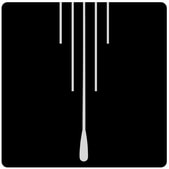Saxophone Set-Up, Care, and Cleaning
- Set your case down on a flat surface, and make sure the latches on the case open upwards. You don’t want to open the case upside down! Some very old cases may be the opposite – the latches open toward the bottom of the case. In this instance, a sticker placed on the top of the case will ensure you never open it upside down.
- Build from the smallest pieces, starting with the reed and mouthpiece:
- Loosen the screws on the ligature (but do not remove them).
- Slide the reed into the ligature. The reed should line up with the tip of the mouthpiece so that if you are looking at it straight on, you should just barely see the tip of the mouthpiece. The screws on the ligature will always point to the right.
- Tighten the ligature. It should only cover the hard part of the reed (you’ll see a line on the reed separating the soft end from the hard – don’t cross this line). The ligature should also only cover the barrel of the mouthpiece (that is, don’t let it hang over the sloped part, called the beak). You only need to tighten the screws enough to keep the reed snugly in place.
- Combine the upper and lower joints of the clarinet by slowly rotating and pushing them together. There is a key that hangs off of the bottom of the upper and joint and covers a piece on the top of the lower joint – watch these pieces as you connect the joints to avoid bending them, and ensure the metal piece on the upper joint is on top.
- Gently push the mouthpiece all the way onto the barrel, rotating the mouthpiece as you push it onto the cork, and then push the barrel onto the upper joint in the same manner. How far you need to push the barrel onto the upper joint depends on the clarinet, as this effects the tuning. You’ll eventually learn what works best. When on correctly, the reed will be facing the ground.
- Push and rotate the bell onto the lower joint.
- If you’re having trouble connecting the mouthpiece, barrel, joints, or bell, add a light amount of cork grease. Don’t force any pieces together or you may crack them.
- Double check the alignment of the instrument: all of the keys should be flat, on the same plane. The keys face the ceiling while the reed faces the floor.
- Always clean out your instrument with a cleaning swab when you are done playing it. These can be purchased online or at any music store. Slowly run the swab through the mouthpiece, barrel, and joints of the clarinet.
- Note that many cleaning swabs are a little too large for a may need to be cut down to avoid it snagging on pieces inside instrument. If a swab does snag, very carefully work the swab out – bent tubing inside the clarinet is very challenging and expensive to repair.
- The mouthpiece and barrel can be cleaned with warm water, mild soap, and a non-abrasive cloth (preferably silk). Do not use anything abrasive (such as paper towels) to clean any part of your clarinet! Even tiny scratches on the inside can have a major effect on its sound quality. Never boil a mouthpiece to disinfect it. Disinfectant sprays for wind instruments are available for purchase, but unless one is frequently sharing their mouthpiece, they aren’t usually necessary.
- Never submerge your clarinet in water! If it needs a deep cleaning, take it to an instrument repair shop where they have a special method for cleaning instruments.
- Never attempt to polish your instrument. If necessary, smudges can be removed with a very damp cloth and some mild soap.
- Your instrument is fragile, so be sure to hold it carefully and closely. It is very easy to bump the instrument against objects around you, including your body or chair, and it’s even easier to crack the reed if you aren’t aware of it. Denting your instrument could make it unplayable!
- Ideally, a technician should check out your instrument once a year. They will check for air leakages, faulty pads, sticky keys, loose screws, and other issues. Most annual tune-ups cost around $70-$100.
- Avoid exposing your instrument to large swings in temperature and climate. Don’t store it outside or in your car. Sudden changes in climate can effect the instrument’s tuning, and in extreme cases may even crack it, especially for wooden clarinets.

